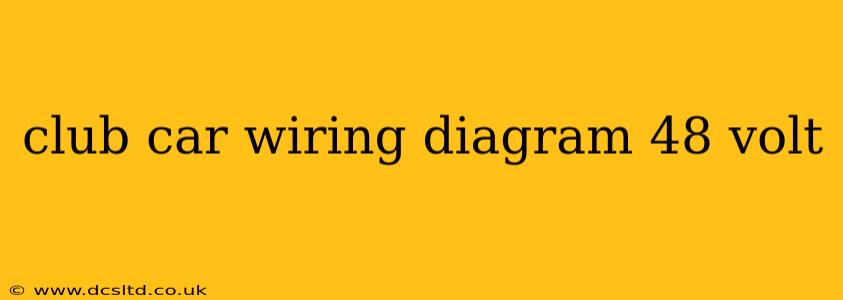Understanding your Club Car's electrical system is crucial for maintenance, troubleshooting, and even upgrades. This guide delves into the intricacies of a 48-volt Club Car wiring diagram, providing a clear understanding of its components and functionality. While specific diagrams vary slightly depending on the model year and features, the core principles remain consistent. This explanation will focus on the common elements and provide troubleshooting tips.
What are the Main Components of a 48-Volt Club Car Electrical System?
A 48-volt Club Car's electrical system, unlike a 36-volt system, uses eight 6-volt batteries wired in series to achieve the higher voltage. This higher voltage allows for more power and typically a faster top speed. The key components include:
- Battery Pack: The heart of the system, composed of eight 6-volt batteries connected in series. Proper connection and maintenance are critical.
- Solenoid: This is an electrically operated switch that controls the high current flow to the motor. It's a critical safety and control component.
- Motor Controller: This sophisticated device regulates the power supplied to the motor, controlling speed and acceleration. It often incorporates safety features like over-current protection.
- Motor: The drive motor converts electrical energy into mechanical energy, propelling the Club Car.
- Wiring Harness: A complex network of wires connecting all components. Its integrity is essential for proper functioning.
- Fuses and Circuit Breakers: These safety devices protect the system from overloads and short circuits.
- Lights and Accessories: Headlights, taillights, turn signals, and other accessories draw power from the system.
- Key Switch: Controls the power flow to the rest of the system.
How to Interpret a Club Car 48-Volt Wiring Diagram
Club Car wiring diagrams utilize standardized symbols to represent different components. These symbols are usually accompanied by labels and numbers, providing a roadmap of the electrical flow. You'll typically find:
- Symbols: Standardized representations of batteries, solenoids, motors, switches, fuses, and other components.
- Wire Colors: Different colors represent different circuits and functionalities, aiding in tracing the flow of electricity.
- Circuit Numbers: These numbers help identify specific circuits and troubleshoot issues.
- Component Labels: Clear identification of each component, making it easy to locate them in the vehicle.
Where Can I Find a Club Car 48-Volt Wiring Diagram?
Finding a specific diagram for your Club Car model can be done in several ways:
- Club Car's Official Website: Their website may have downloadable service manuals, often including wiring diagrams.
- Online Forums and Communities: Many online forums dedicated to Club Cars have users who share diagrams and troubleshooting tips. Be sure to verify the accuracy of the information.
- Authorized Club Car Dealers: Your local dealer will likely have access to diagrams and service manuals for your specific model.
- Third-Party Repair Manuals: Some aftermarket repair manuals provide detailed wiring diagrams.
Remember to always use caution when working with electrical systems. Disconnecting the batteries is the first and most crucial safety step.
What are the Common Problems Associated with the 48-Volt Wiring System?
Common problems often stem from corroded battery connections, faulty solenoids, issues with the motor controller, or damaged wiring. Troubleshooting involves systematic checks, starting with visual inspections for obvious damage, followed by testing individual components with a multimeter.
How Do I Troubleshoot a Problem with My Club Car's 48-Volt System?
Troubleshooting requires a methodical approach:
- Visual Inspection: Carefully examine the wiring harness for any signs of damage, corrosion, or loose connections. Check all battery connections for corrosion.
- Battery Voltage Check: Using a multimeter, measure the voltage of each individual battery and the entire battery pack. Low voltage indicates a problem with one or more batteries.
- Solenoid Testing: Test the solenoid's operation to ensure it's switching correctly.
- Motor Controller Diagnostics: If the problem persists, the motor controller might require professional diagnosis and repair.
Remember, working with high voltage can be dangerous. If you are not comfortable working with electrical systems, seek the assistance of a qualified technician.
This guide provides a general overview. Specific diagrams and troubleshooting steps vary depending on the Club Car model and year. Always consult your owner's manual or a qualified technician for specific instructions related to your vehicle.
